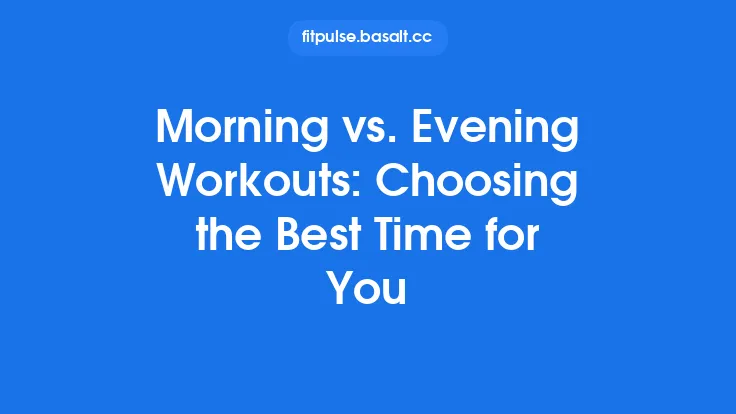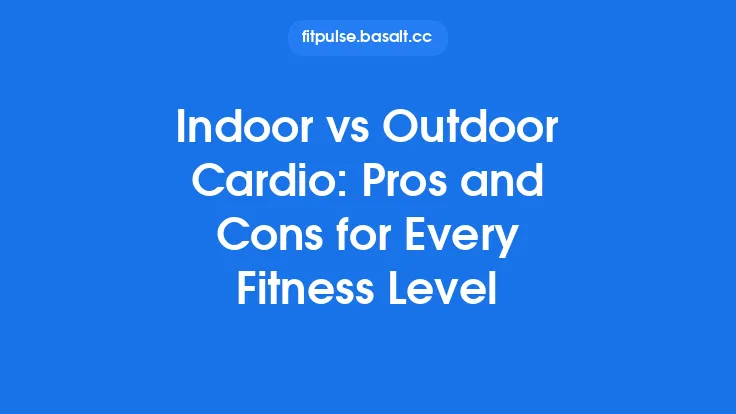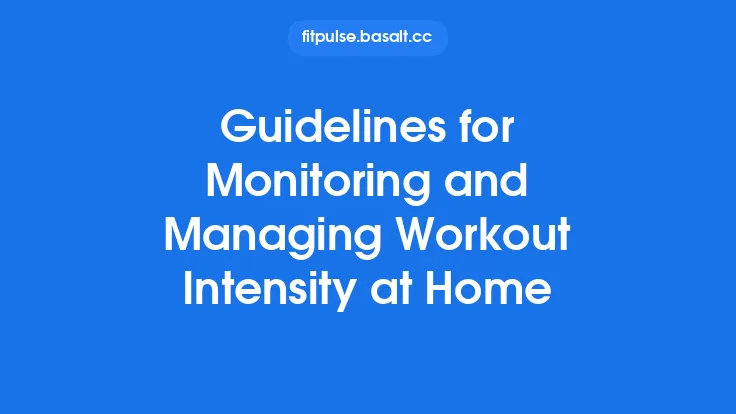When designing a training program, the way we think about volume and intensity must shift depending on whether the work is primarily resistance‑based (e.g., weightlifting, body‑weight exercises) or cardiovascular (e.g., running, cycling, rowing). Although the two terms are used across all forms of exercise, their operational definitions, measurement units, and practical implications differ markedly between these modalities. Understanding those differences is the first step toward prescribing a coherent, effective plan that respects the unique physiological demands of each type of work.
Defining Volume and Intensity Across Modalities
| Concept | Resistance Training | Cardiovascular Training |
|---|---|---|
| Volume | The total amount of mechanical work performed, typically expressed as the product of load, repetitions, and sets (often summed across exercises to yield “tonnage”). | The total amount of aerobic work, usually quantified by time, distance, or energy expenditure (e.g., minutes run, kilometers cycled, kilocalories burned). |
| Intensity | The relative load lifted compared to an individual’s maximal capacity (e.g., a percentage of one‑rep max) or the speed of movement (e.g., meters per second in a power lift). | The relative demand placed on the cardiovascular system, expressed as a percentage of maximal oxygen uptake (VO₂max), maximal heart rate (HRmax), or power output (watts). |
These definitions are not interchangeable. A 10‑minute jog at 70 % HRmax is a high‑intensity cardiovascular session but would be considered low intensity if the same time were spent performing body‑weight squats with a light load. Conversely, a single set of heavy deadlifts at 90 % 1RM may involve minimal cardiovascular volume yet represent a very high‑intensity stimulus for the neuromuscular system.
Quantifying Volume in Resistance Training
- Mechanical Work (Tonnage)
- Formula: Load × Reps × Sets.
- Summing this product across all exercises in a session yields a session‑level tonnage; aggregating across a week provides a weekly volume metric.
- Tonnage captures both the magnitude of the load and the repetition scheme, offering a single number that reflects total mechanical stress placed on the musculoskeletal system.
- Set‑Based Approaches
- Some coaches prefer to count total sets per muscle group rather than calculate tonnage. This method abstracts away the exact load, focusing instead on the frequency of stimulus.
- While less precise, set counts are useful when loads vary widely (e.g., alternating heavy and light days) or when the primary goal is neural adaptation rather than hypertrophic stress.
- Time Under Tension (TUT)
- For slower, controlled lifts, the cumulative time a muscle spends under load can be a meaningful volume proxy.
- TUT is especially relevant for exercises where load is limited (e.g., body‑weight movements) but the practitioner can manipulate tempo to increase mechanical stress.
Quantifying Volume in Cardiovascular Training
- Time‑Based Volume
- The simplest metric: total minutes spent in a given activity.
- Useful for modalities where distance is not easily measured (e.g., indoor rowing, elliptical training).
- Distance‑Based Volume
- Common for running, cycling, swimming, and rowing.
- Distance can be converted to work using known energy costs (e.g., kcal per kilometer for running).
- Energy Expenditure
- Modern wearables estimate kilocalories burned, providing a unified volume metric across disparate activities.
- Energy‑based volume is particularly valuable when comparing modalities (e.g., a 45‑minute bike ride vs. a 30‑minute swim).
- Session‑Level “Training Load”
- Some platforms calculate a composite load by multiplying duration by an intensity factor (e.g., HR‑based training impulse).
- This hybrid metric bridges the gap between pure time/distance and physiological stress.
Intensity Metrics for Resistance Workouts
| Metric | Description | Typical Use |
|---|---|---|
| Load Percentage | Load expressed as a proportion of an individual’s maximal single‑rep capability (e.g., 75 % 1RM). | Sets with moderate to high loads, strength‑oriented phases. |
| Velocity/Power | Mean or peak bar speed (m/s) or power output (W) measured with a linear transducer or wearable. | Explosive training, power development, auto‑regulation. |
| Repetition Tempo | Prescribed speed of the eccentric and concentric phases (e.g., 3‑0‑1). | Manipulating time under tension, controlling fatigue. |
Intensity in resistance training is fundamentally about the mechanical demand placed on the muscle‑tendon unit. The higher the load or the faster the movement, the greater the neural and muscular recruitment required.
Intensity Metrics for Cardiovascular Workouts
| Metric | Description | Typical Use |
|---|---|---|
| % VO₂max | Proportion of maximal oxygen uptake; reflects metabolic demand. | Structured interval training, aerobic base building. |
| % HRmax or HR Reserve | Heart rate expressed relative to maximal or resting values. | Easy‑moderate zones, recovery sessions. |
| Power Output (Watts) | Direct measurement of mechanical work (e.g., cycling power meter). | Threshold training, sprint intervals. |
| Perceived Exertion | Subjective rating (e.g., Borg scale) that correlates with physiological strain. | Situations where heart rate monitoring is impractical. |
Cardiovascular intensity is about how hard the heart‑lung system must work to supply oxygen and remove metabolites. Unlike resistance work, the same absolute mechanical load can be performed at vastly different intensities simply by altering speed, cadence, or grade.
Integrating Volume and Intensity Within a Training Cycle
Both modalities benefit from periodized fluctuations in volume and intensity, but the shape of those fluctuations differs:
- Resistance‑Focused Cycles
- Accumulation Phase: Higher volume (more sets, moderate loads) with lower intensity to build work capacity.
- Intensification Phase: Volume tapers while load percentages rise, sharpening strength and power.
- Realization/Peak Phase: Minimal volume, maximal intensity, often featuring single‑rep or low‑rep heavy lifts.
- Cardiovascular‑Focused Cycles
- Base Phase: Predominantly low‑to‑moderate intensity, high time‑based volume to develop aerobic foundation.
- Build Phase: Introduction of higher‑intensity intervals (e.g., tempo runs, threshold rides) while maintaining overall volume.
- Peak Phase: Volume may be reduced, but intensity peaks with race‑specific efforts (e.g., VO₂max intervals, sprint repeats).
The key distinction is that resistance cycles often invert the volume‑intensity relationship (high volume → low intensity, then low volume → high intensity), whereas cardiovascular cycles tend to layer intensity on top of a relatively stable volume base, only reducing volume near competition or testing phases.
Practical Prescription Strategies
1. Establish a Baseline Metric for Each Modality
- Resistance: Choose a reference load (e.g., 70 % 1RM) and record the total tonnage achieved in a typical session.
- Cardio: Record a baseline weekly time or distance at a moderate intensity (e.g., 45 minutes of running at 65 % HRmax).
2. Define the Desired Training Phase
- Strength/Power Emphasis (Resistance): Increase load percentage by 5‑10 % while cutting total sets by 20‑30 %.
- Aerobic Endurance Emphasis (Cardio): Add 10‑15 % more minutes per week, keeping intensity within 60‑70 % HRmax.
3. Apply a Structured Progression Model
- Linear Progression: Add a fixed amount of volume each week (e.g., +5 % tonnage or +5 minutes) while holding intensity constant for 3‑4 weeks, then increase intensity in the following block.
- Undulating Progression: Rotate weekly focus (e.g., high‑volume/low‑intensity week → low‑volume/high‑intensity week) to stimulate varied adaptations without prolonged monotony.
4. Use Modality‑Specific Tools for Precision
- Resistance: Bar‑speed devices, load‑cell platforms, or simple load logs to track tonnage.
- Cardio: Heart‑rate monitors, power meters, GPS watches, or wearable metabolic estimators.
5. Align Session Structure with the Phase Goal
- Resistance Example (Intensification Week):
- Warm‑up: 2 × 5 reps at 50 % 1RM.
- Main lifts: 4 × 3 reps at 85 % 1RM (total tonnage reduced vs. accumulation week).
- Accessory work: 2 × 8 reps at 60 % 1RM (maintain some volume for hypertrophy).
- Cardio Example (Build Week):
- Warm‑up: 10 minutes easy jog (50‑55 % HRmax).
- Main set: 4 × 5 minutes at 85 % VO₂max with 2 minutes recovery (interval intensity high, overall volume modest).
- Cool‑down: 10 minutes easy spin (55‑60 % HRmax).
Monitoring and Adjusting the Prescription
- Objective Data Capture
- Record tonnage, sets, reps, and load for resistance sessions.
- Log duration, distance, average heart rate, and power for cardio sessions.
- Physiological Feedback
- Track resting heart rate trends, sleep quality, and perceived recovery. Sudden spikes may signal that volume or intensity is excessive for the current recovery capacity.
- Performance Markers
- Resistance: Weekly changes in bar speed or ability to complete prescribed reps at a given load.
- Cardio: Shifts in pace at a fixed HR zone or power output at a given VO₂% level.
- Iterative Adjustment
- If performance markers plateau while physiological stress remains low, consider a modest increase in volume.
- If markers regress and subjective fatigue rises, reduce either volume or intensity for the subsequent block, depending on which variable was most stressed in the prior phase.
Modality‑Specific Considerations
- Neuromuscular Fatigue vs. Metabolic Fatigue
Resistance work primarily taxes the neuromuscular system; therefore, volume spikes can lead to rapid declines in motor unit firing rates. Cardio work, by contrast, accumulates metabolic by‑products (lactate, hydrogen ions) that affect endurance capacity. Prescriptions should respect these distinct fatigue pathways.
- Equipment Constraints
Power meters are commonplace in cycling but rare in free‑weight training; conversely, velocity transducers are abundant in strength labs but not in most running clubs. Choose the most reliable, accessible metric for each modality.
- Skill Component
Technical proficiency (e.g., squat depth, running gait) can dominate the response to volume and intensity. Early phases should prioritize technique, using lower intensities and moderate volumes to embed proper movement patterns before loading intensifies.
- Environmental Influences
Temperature, altitude, and terrain dramatically affect cardiovascular intensity (HR, VO₂) but have a lesser impact on resistance load. When prescribing cardio volume/intensity, factor in environmental stressors; for resistance, adjust load based on day‑to‑day readiness rather than external conditions.
By treating volume and intensity as modality‑specific constructs—mechanical work for resistance and aerobic work for cardio—coaches and athletes can craft prescriptions that align with the underlying physiology of each activity. The result is a training program that leverages the strengths of each modality, minimizes unnecessary cross‑over confusion, and ultimately drives more consistent, sustainable progress.





